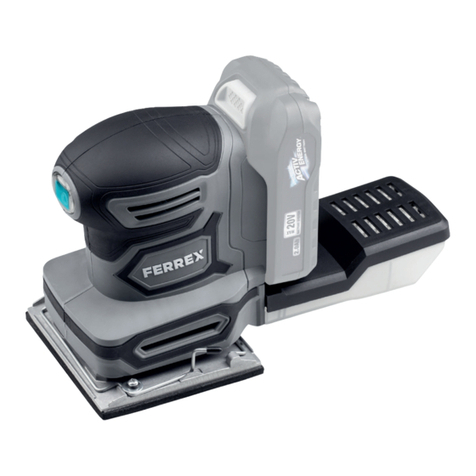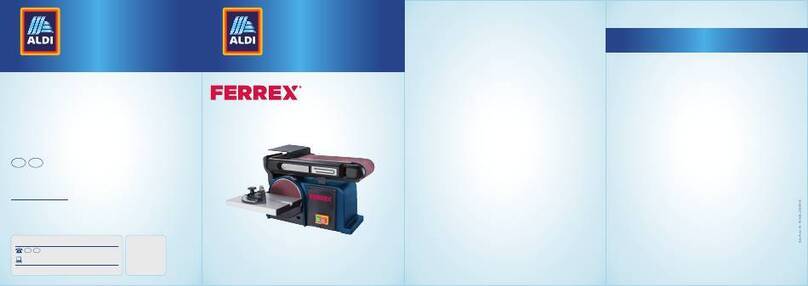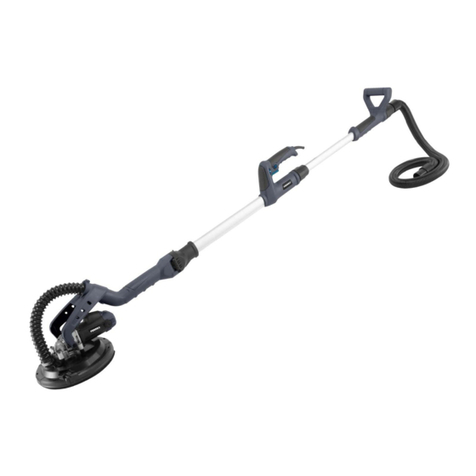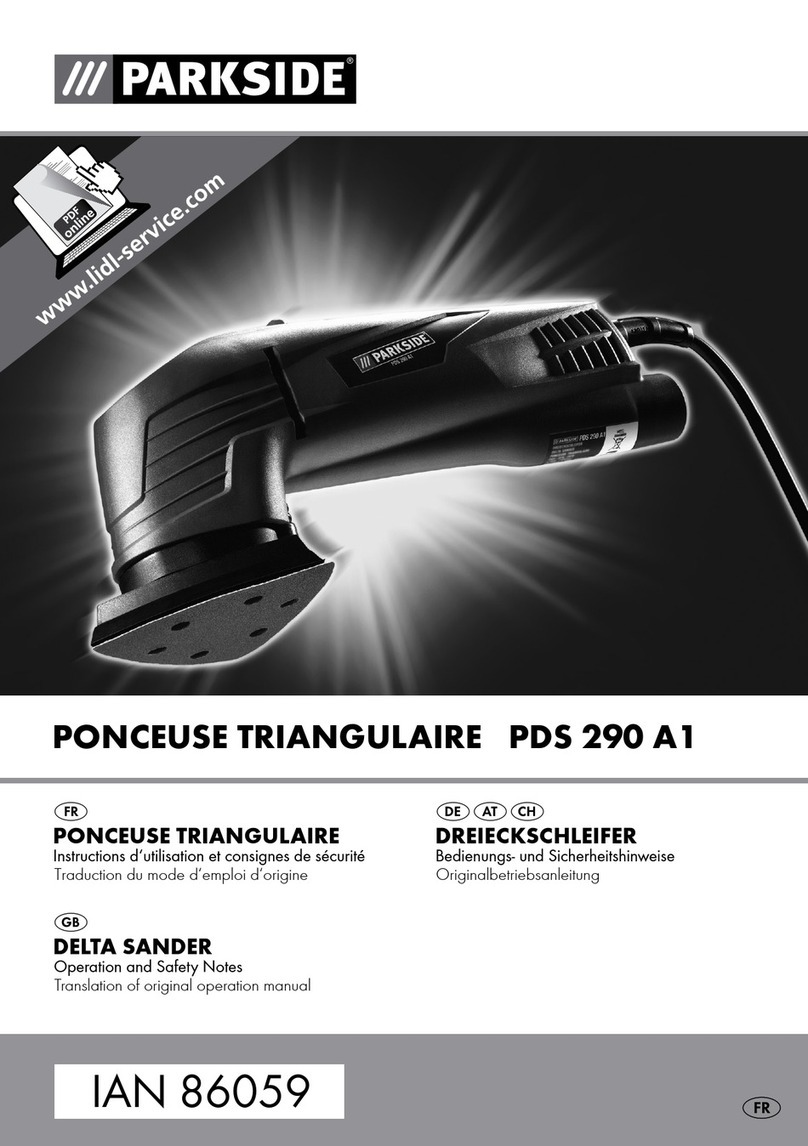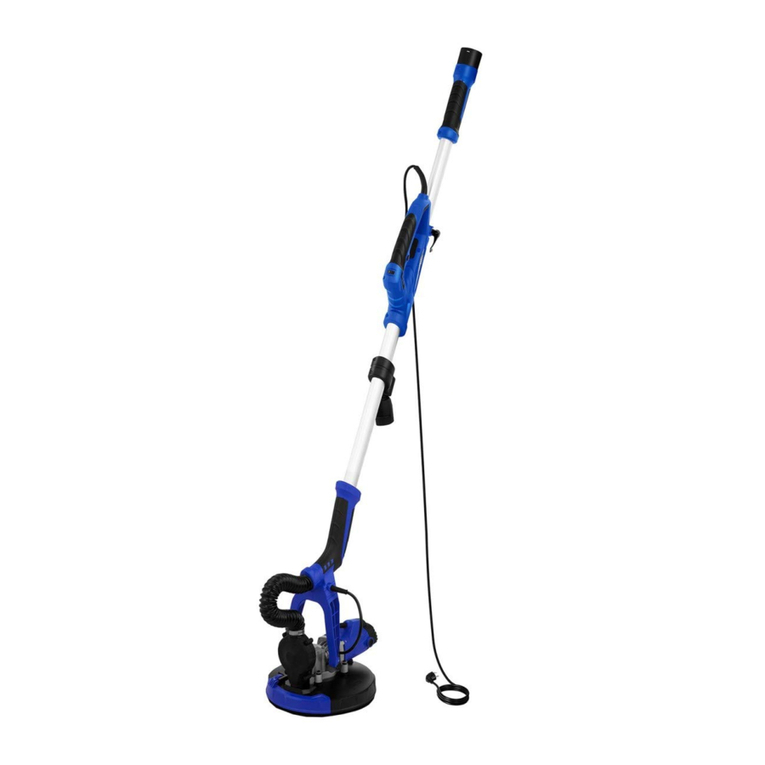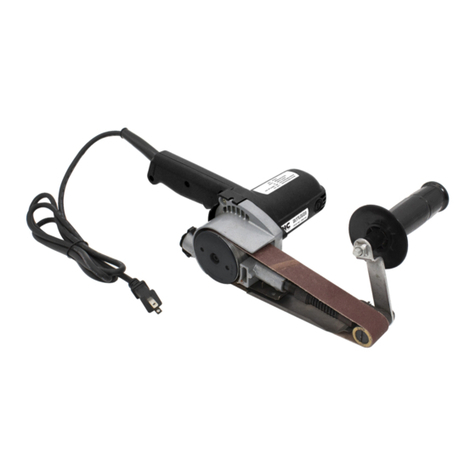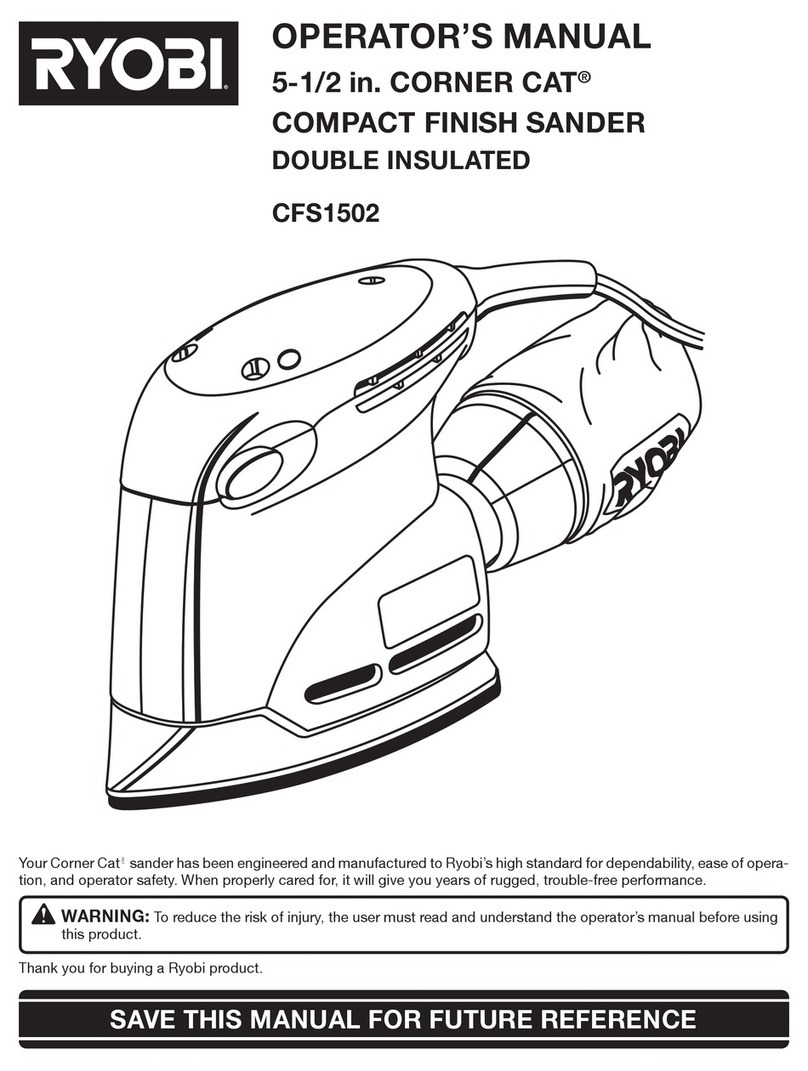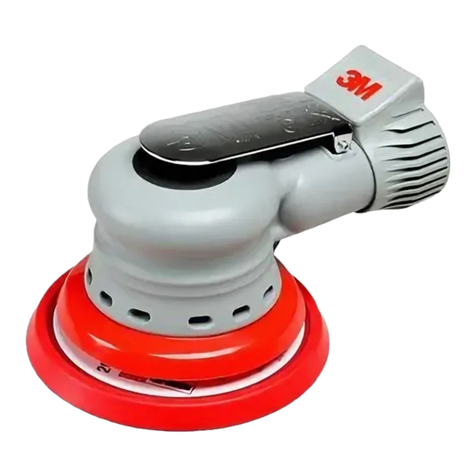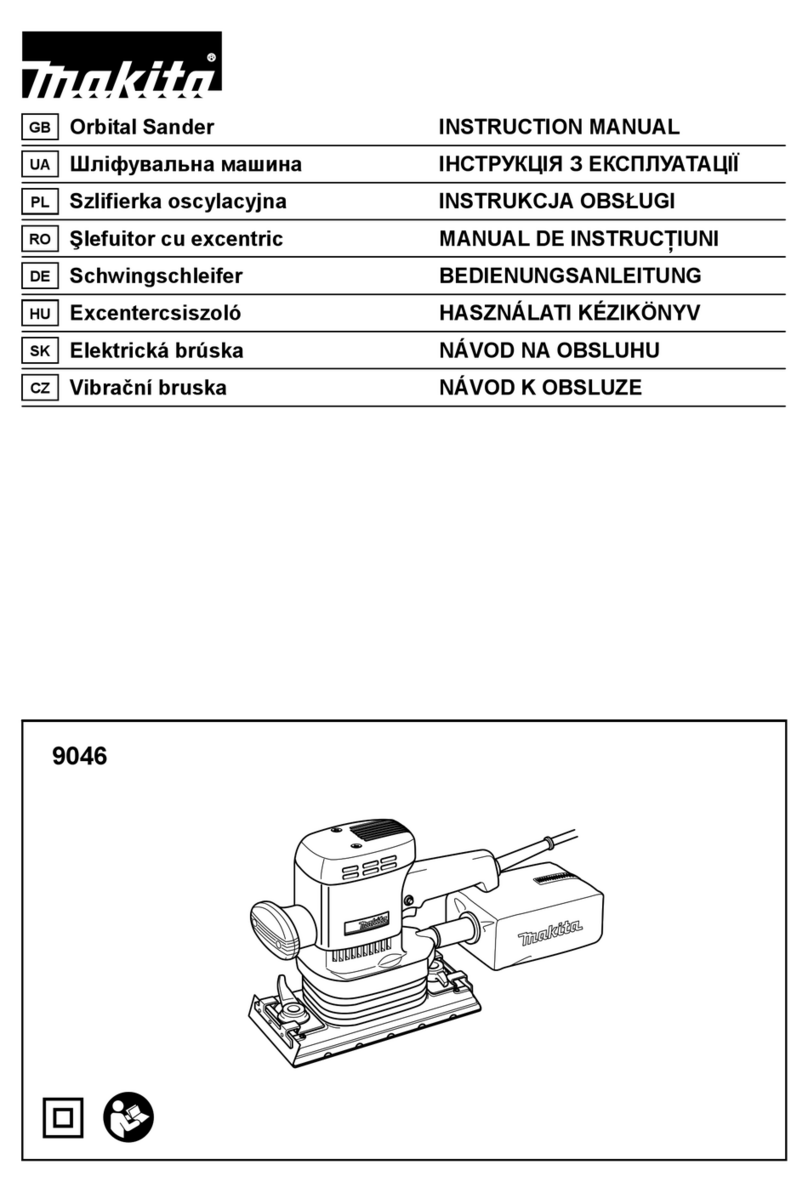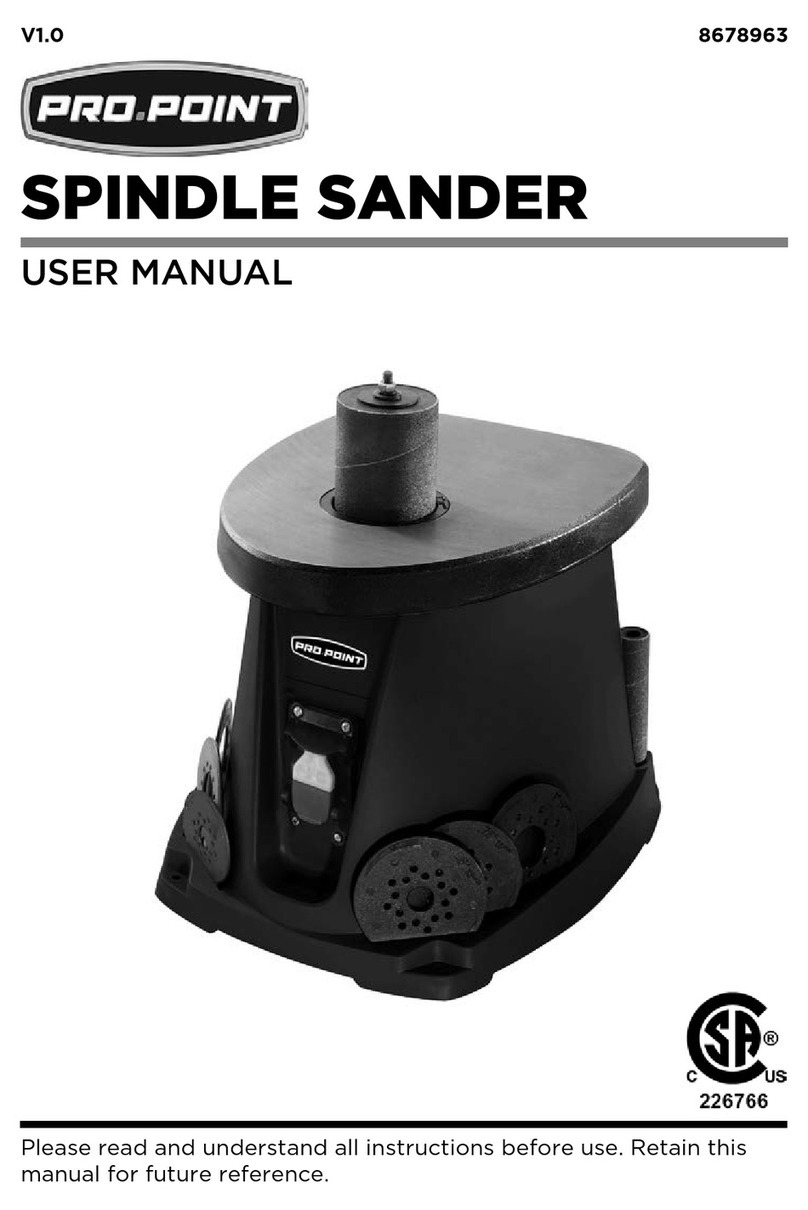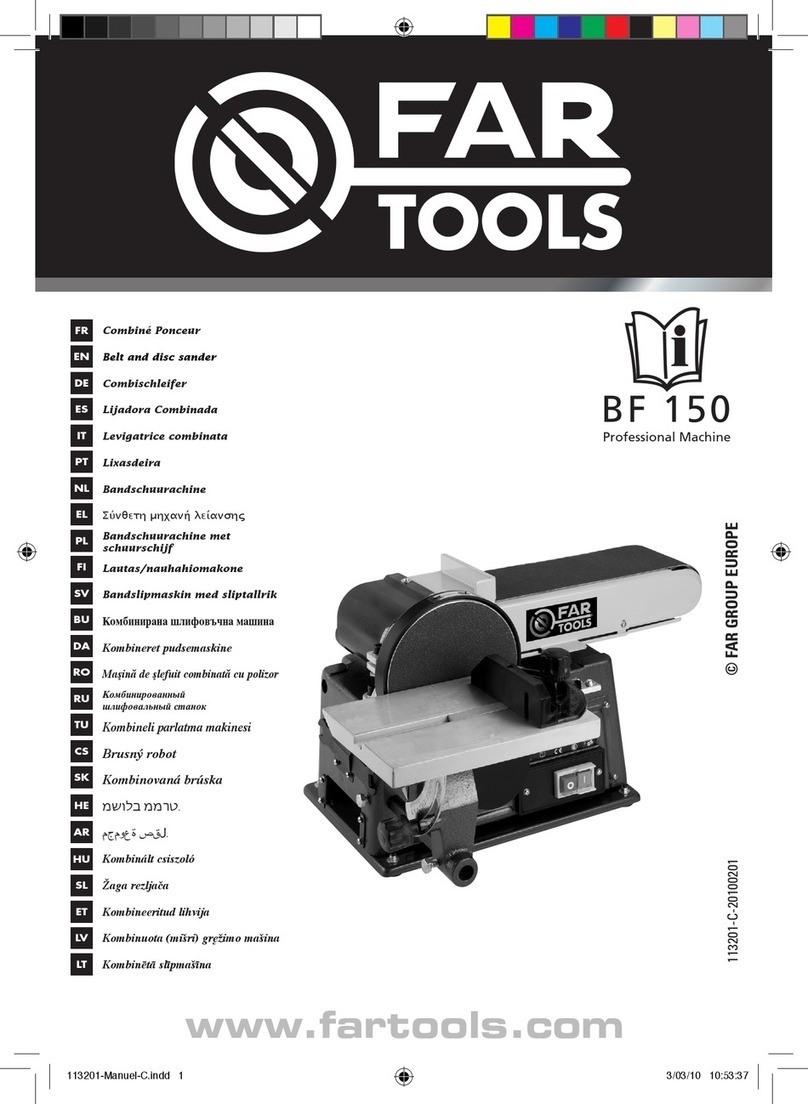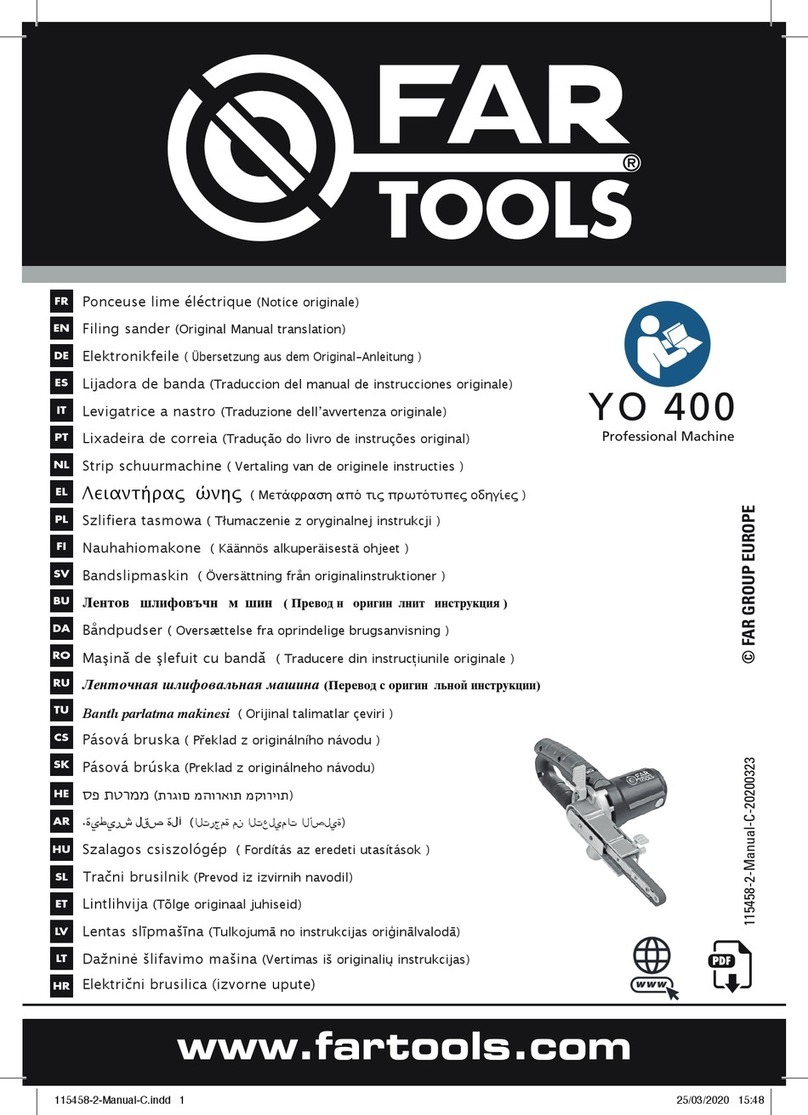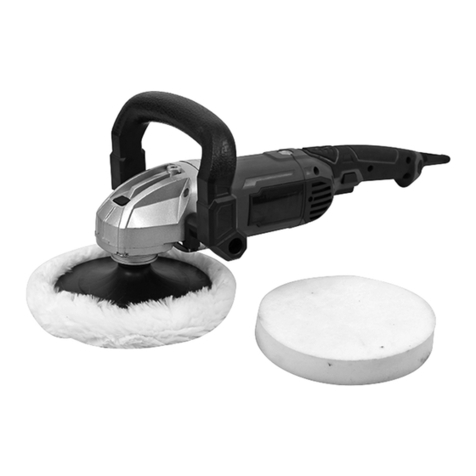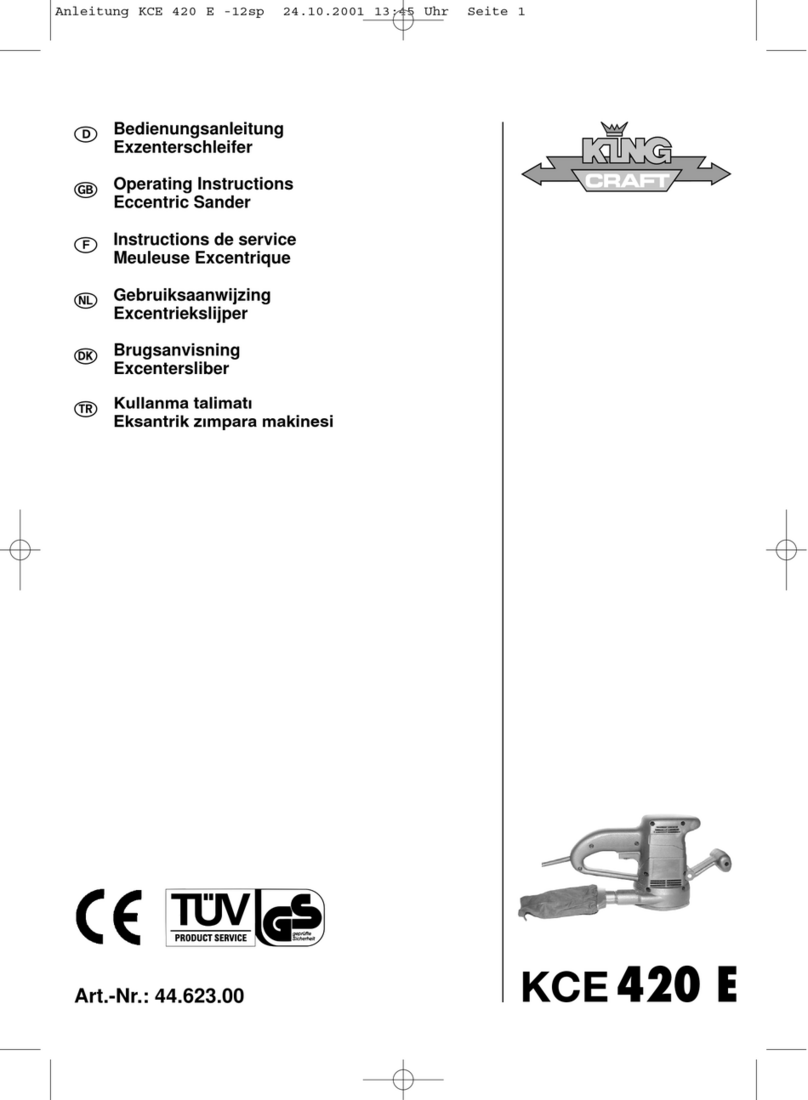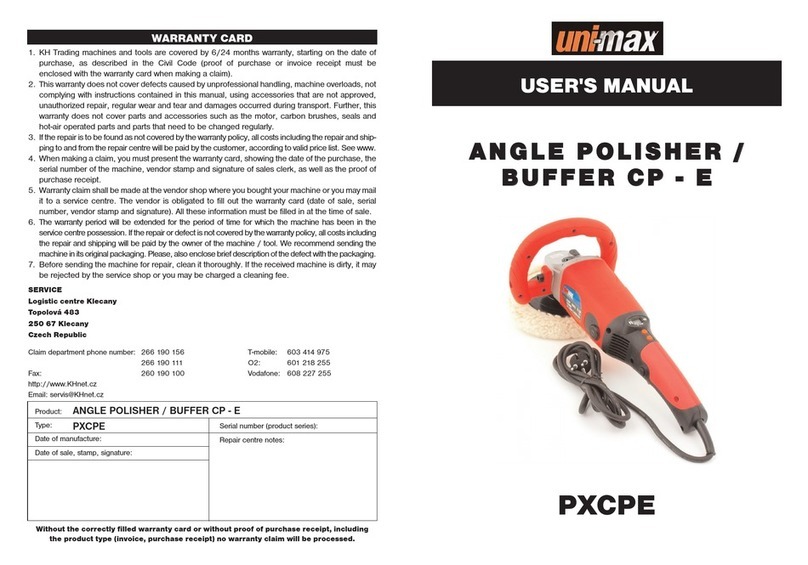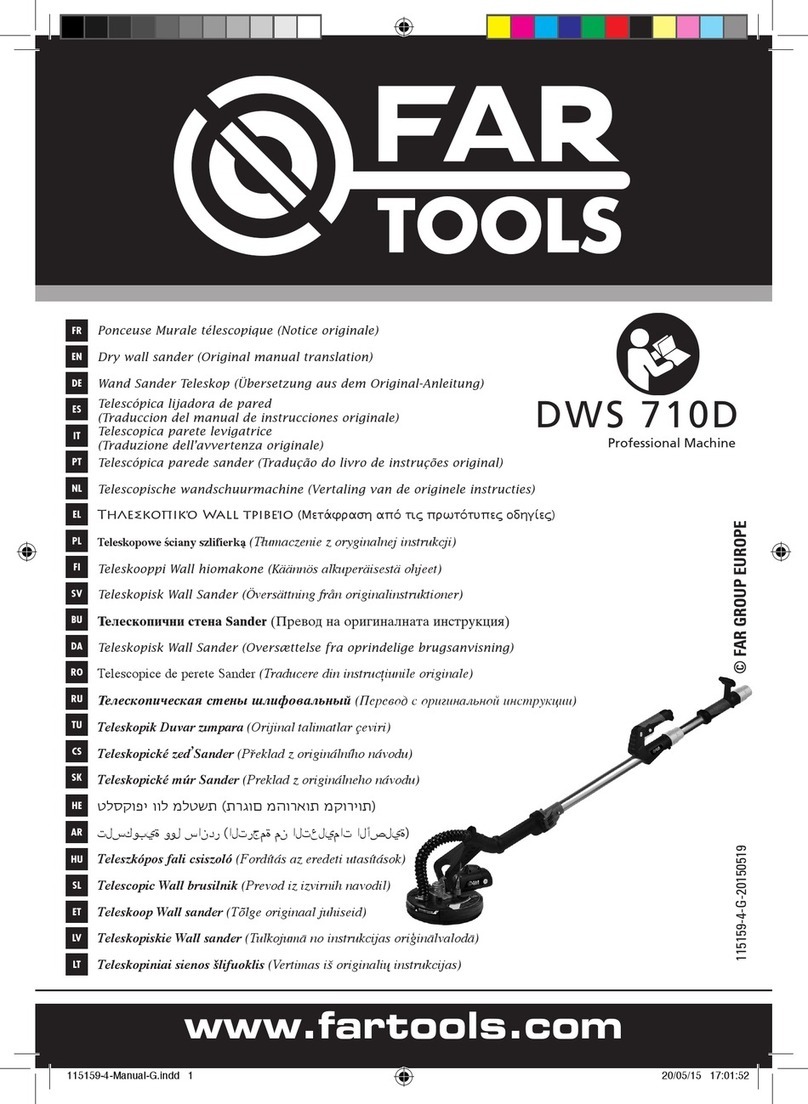FERREX FAES 20-I User manual

ID: #05007
m
y
h
a
n
s
e
c
o
n
t
r
o
l
.
c
o
m
M
A
N
U
A
L
D
E
V
E
L
O
P
E
D
I
N
G
E
R
M
A
N
Y
User-friendly
Manual
User manual
20 V LI-ION CORDLESS
ROTARY SANDER
FAES 20-I
Original instructions

1
3
2
Dok./Rev.-Nr. 200046_20220704

Contents
3
Contents
1Rotary sander
2Dust container
3Vacuum adapter

Table of contents
4
Table of contents
Contents .......................................................................................................... 3
General information ....................................................................................... 5
Reading and storing the user manual ..................................................................5
Proper use..................................................................................................................5
Residual risks.............................................................................................................6
Explanation of symbols .................................................................................. 6
Safety............................................................................................................... 7
Explanation of notes ................................................................................................ 7
General power tool safety instructions ................................................................. 7
Supplementary safety instructions ...................................................................... 11
Product description .......................................................................................15
First use ..........................................................................................................16
Checking the product and package contents.................................................... 16
Use ..................................................................................................................16
Attaching/detaching dust container................................................................... 16
Using a vacuum adapter.........................................................................................17
Attaching/detaching an external dust extraction device.................................17
Inserting the battery...............................................................................................17
Extracting the battery............................................................................................ 18
Attaching/replacing sanding sheet..................................................................... 19
Setting the speed....................................................................................................20
Switching the product on and off ........................................................................20
Sanding and polishing............................................................................................21
Faults and troubleshooting.......................................................................... 24
Cleaning and maintenance .......................................................................... 24
Cleaning ...................................................................................................................25
Maintenance and care............................................................................................26
Storage .....................................................................................................................26
Transport..................................................................................................................26
Technical data ............................................................................................... 26
Battery and charger information......................................................................... 27
Noise/vibration information .........................................................................27
Disposal ......................................................................................................... 29
Disposing of the packaging ..................................................................................29
Disposing of the product .......................................................................................29
Declaration of conformity............................................................................. 30

General information
5
General information
Reading and storing the user manual
This user manual accompanies this 20 V Li-Ion cordless rotary sander
FAES 20-I (referred to below only as the “product”). It contains important
information on safety, usage and care.
Before using the product, read the user manual carefully. Pay particular
attention to the safety notes and warnings. Failure to comply with the instructions in
this user manual may result in severe injury or damage to the product.
Comply with valid local or national provisions concerning the use of this product. Keep
this user manual in a safe place for future reference. Make sure to include this user
manual when passing the product on to third parties.
Proper use
The product is only suitable for private users in connection with hobby and DIY pro-
jects. It works only in dry sanding and, with the appropriate accessories, is suitable for
sanding and polishing:
• wood,
• metal,
• mineral substrates.
Any other applications are expressly prohibited and are deemed improper use.
Neither the manufacturer nor the retailer can accept any responsibility for injury, loss
or damage of any kind caused by misuse of this product. Examples of misuse are giv-
en in the following non-exhaustive list:
• Using the product for other purposes other than those intended;
• Failure to observe the safety notes and warnings as well as the assembly, operat-
ing, maintenance and cleaning instructions contained in this user manual;
• Failure to comply with any regulations relating to accident prevention, occupa-
tional health or safety, which specifically and/or generally apply to the use of the
product;
• Use of accessories and spare parts not intended for the product;
• Changes to the product;
• Product repairs performed by parties other than the manufacturer or a qualified
professional;
• Use of the product for commercial, artisan or industrial purposes;
• Operation or maintenance of the product by persons not familiar with how to
handle the product and/or who are not aware of the related risks.

Explanation of symbols
6
Residual risks
Despite proper use, inconspicuous residual risks cannot be completely ruled out.
The following risks may arise due to the design of the product:
• Touching the running sanding sheet (abrasion injury);
• Kickback of the workpiece and parts of the workpiece if used improperly;
• Injury caused by projected workpieces or parts of workpieces;
• Fire hazard due to blocked ventilation slots.
Explanation of symbols
The following symbols are used in this user manual, on the product or on the
packaging.
This symbol provides you with useful supplementary information on
assembly or operation.
Declaration of conformity (see chapter “Declaration of conformity”):
Products marked with this symbol meet all applicable Community regu-
lations for the European Economic Area.
Read the user manual.
Wear protective goggles.
Wear a dust mask.
Wear ear protection.
Wear suitable protective gloves.

Safety
7
Safety
Explanation of notes
The following symbols and signal words are used in this user manual.
WARNING!
Indicates a hazardous situation that, if not avoid-
ed, could result in death or serious injury.
CAUTION!
Designates a dangerous situation that may result
in minor or moderate injury if not avoided.
NOTICE!
Warns against potential damages to property.
General power tool safety instructions
WARNING Read all the safety notes, instructions, illustrations and
technical details supplied with this power tool. Failure to follow the safety
notices and instructions may result in an electric shock, fire and/or severe
injury.
Save all warnings and instructions for future reference.
The term “power tool” used in the safety instructions refers to mains-operated
power tools (corded) and battery-powered power tools (cordless).
Work area safety
a) Keep your work area clean and well lit.
Cluttered or dark areas
invite accidents.
b) Do not operate power tools in explosive atmospheres, such as
in the presence of flammable liquids, gases or dust.
Power tools
create sparks which may ignite the dust or fumes.
c) Keep children and bystanders away while operating a power
tool.
If you are distracted, you could lose control of the power tool.
Electrical safety
a) Power tool plugs must match the outlet. Never modify the plug in
any way. Do not use any adapter plugs with earthed (grounded)
power tools.
Unmodified plugs and matching outlets will reduce risk
of electric shock.

Safety
8
b) Avoid body contact with earthed or grounded surfaces, such as
pipes, radiators, ranges and refrigerators.
There is an increased
risk of electric shock if your body is earthed or grounded.
c) Do not expose power tools to rain or wet conditions.
Water enter-
ing a power tool will increase the risk of electric shock.
d) Do not use the cord for improper purposes such as for carrying the
power tool, for hanging it up or for pulling or unplugging it from
the socket. Keep cord away from heat, oil, sharp edges and moving
parts.
Damaged or entangled cords increase the risk of electric shock.
e) When operating a power tool outdoors, use only extension cords
that are suitable for outdoor use.
Use of a cord suitable for outdoor
use reduces the risk of electric shock.
f) If operating a power tool in a damp location is unavoidable, use
a residual current device (RCD) protected supply.
Use of an RCD
reduces the risk of electric shock.
Personal safety
a) Stay alert, watch what you are doing and use common sense
when operating a power tool. Do not use a power tool while you
are tired or under the influence of drugs, alcohol or medication.
A moment of inattention while operating power tools may result in
serious personal injury.
b) Use personal protective equipment. Always wear eye protection.
Protective equipment such as dust mask, non-skid safety shoes, hard
hat, or hearing protection used for appropriate conditions will reduce
personal injuries.
c) Prevent unintentional starting. Ensure the switch is in the off-po-
sition before connecting to power source and/or battery pack,
picking up or carrying the tool.
Carrying power tools with your
finger on the switch or connecting the power tool to a power supply
while the switch is set to “on” may lead to accidents.
d) Remove any adjusting key or wrench before turning the power
tool on.
A wrench or a key left attached to a rotating part of the pow-
er tool may result in personal injury.
e) Take care to keep a normal body position. Maintain a stable
stance and balance at all times.
This enables better control of the
power tool in unexpected situations.

Safety
9
f) Dress properly. Do not wear loose clothing or jewellery. Keep
your hair and clothing away from moving parts.
Loose clothes,
jewellery or long hair can be caught in moving parts.
g) If there is an option for installing dust suction devices and dust
containers, these should be attached and used correctly.
Use of
dust collection can reduce dust-related hazards.
h) Do not be lulled into a false sense of security and ignore the
safety rules for power tools, even if you are well acquainted with
power tools, having used them frequently.
Using power tools
without due care and attention can cause serious injuries in a split
second.
Power tool use and care
a) Do not overload the power tool. Use the correct power tool for
your application.
The correct power tool will do the job better and
safer at the rate for which it was designed.
b) Do not use the power tool if the switch does not turn it on and
off.
Any power tool that cannot be controlled with the switch is dan-
gerous and must be repaired.
c) Disconnect the plug from the power source and/or remove the
rechargeable battery from the power tool before making any
adjustments, changing insertion tools or storing the power tool.
Such preventive safety measures reduce the risk of starting the pow-
er tool accidentally.
d) Store idle power tools out of the reach of children. Do not let any
individual who is not familiar with the power tool or who has not
read these instructions operate this power tool.
Power tools are
dangerous in the hands of untrained users.
e) Maintain power tools and insertion tools with care. Check for mis-
alignment or binding of moving parts, breakage of parts and any
other condition that may affect the power tool’s operation. If any
parts of the power tool are damaged, have them repaired before
use.
Many accidents are caused by poorly maintained power tools.
f) Keep cutting tools sharp and clean.
Properly maintained cutting
tools with sharp cutting edges are less likely to bind and are easier to
control.

Safety
10
g) Use the power tool, accessories and fitted tools etc. in accordance
with these instructions, taking into account the working con-
ditions and the work to be performed.
Use of the power tool for
operations different from those intended could result in a hazardous
situation.
h) Keep handles and handle surfaces dry, clean and free from oil
and grease.
Slippery handles and handle surfaces will prevent you
from operating and controlling the power tools safely in unforeseen
situations.
Cordless tool use and care
a) Only charge the rechargeable batteries with chargers recom-
mended by the manufacturer.
Chargers designed for a particular
rechargeable battery type pose a risk of fire if used with other types
of rechargeable battery.
b) Only use the rechargeable batteries designated for use in power
tools.
Using other rechargeable batteries may result in injury and a
risk of fire.
c) Keep the unused rechargeable battery away from paper clips,
coins, keys, nails, screws or other small metallic objects that
could bridge the contacts.
A short circuit between the contacts of
the rechargeable battery could result in burns or fire.
d) If used improperly, liquid may leak out of the rechargeable bat-
tery. Avoid coming into contact with it. Rinse with water in the
event of accidental contact. If liquid comes into contact with your
eyes, also seek medical attention.
Fluid leaked from the rechargea-
ble battery may cause skin irritations or burns.
e) Do not use a damaged or modified rechargeable battery.
Dam-
aged or modified rechargeable batteries can be unpredictable and
may result in fire, an explosion or a risk of injury.
f) Do not expose a rechargeable battery to fire or excessively high
temperatures.
Fire or temperatures above 130 °C may cause an
explosion.
g) Follow all instructions for charging and never charge the battery or
cordless tool outside of the temperature range indicated in the user
manual.
Improper charging or charging outside of the permitted tem-
perature range may damage the battery and increase the risk of fire.

Safety
11
Service
a) Have your power tool serviced by a qualified repair person using
only identical replacement parts.
This will ensure that the safety of
the power tool is maintained.
b) Never perform maintenance on damaged rechargeable batteries.
Only the manufacturer or authorised service companies may perform
maintenance on rechargeable batteries.
Supplementary safety instructions
WARNING!
Risk of injury!
This product is not intended to be used by persons with impaired physical, sen-
sory or mental abilities or who lack experience and/or knowledge, unless they
are supervised by a person responsible for their safety or are instructed by such
a person on the use of the device.
− Supervise children to ensure that they do not play with the product.
− Do not let children play with the packaging wrapper. They may get caught
in it when playing and suffocate.
WARNING!
Risk of injury!
Improper handling of the product can lead to injury.
− Use the product for dry sanding work only.
− Use the correct size of sanding sheet and follow the manufacturer’s
instructions for selecting them. Sanding sheets that protrude beyond
the sanding disc can cause injuries as well as hooking and tearing of the
sanding sheets, and kickback.
− Do not use accessories that are not meant for the product. Merely attach-
ing accessories to the product firmly is no guarantee for safe use.
− When working with it, always grip the product with both hands and
assume a stable posture.
− Use clamping devices to secure the workpiece against slipping.

Safety
12
− Always switch on the product before guiding it towards the workpiece.
− Avoid skin contact with the rotating sanding sheet. Protective gloves give
the best protection.
− Do not apply excessive pressure to the product, as this may cause the
sanding sheet to stop rotating.
− When you are not using the product, or when cleaning it, servicing it,
replacing parts or in the event of a fault, always switch the product off and
remove the rechargeable battery.
− After completing operation, always wait for all moving parts to come to a
complete standstill.
− Never allow the product to run while you are carrying it.
− Do not use the product near combustible materials. Sparks could ignite
these materials.
− Do not grind metals with a magnesium content greater than 60 %. This is
a fire hazard.
− Let the product cool down after use before touching it.
WARNING!
Risk of injury!
Rechargeable batteries may contain flammable substances. If batteries are
handled improperly they may leak, become very hot, catch fire or explode
under certain circumstances. Improper handling may result in serious injury.
− Do not short circuit rechargeable batteries. Keep rechargeable batteries
away from metal objects to avoid short circuits. Ideally store the recharge-
able batteries in their original packaging.
− Make sure that the polarity is correct when inserting the rechargeable
batteries.
− Do not heat the rechargeable batteries and do not throw them in an open fire.
− Never expose the rechargeable batteries and the product to direct sunlight.
− Only replace the rechargeable batteries with the same type or an equiva-
lent rechargeable battery type. Refer to the chapter “Technical data”.
− Do not disassemble or modify rechargeable batteries.
− Do not subject rechargeable batteries to mechanical shocks, do not crush
or deform them, and do not drill into them.

Safety
13
− Stop using the rechargeable batteries if they are damaged.
− Rechargeable batteries must not be reactivated by any other means.
− Metallic lithium can lead to fire when it comes into contact with water. Do
not allow the contents of lithium batteries to come into contact with water.
− Remove rechargeable batteries from the product before charging them.
− Keep unused rechargeable batteries out of the reach of children. If chil-
dren or pets swallow rechargeable batteries, immediately contact a
physician.
− Do not allow battery acid to come into contact with skin, eyes or mucus
membranes. In the event of contact with battery acid, immediately flush
the affected area with clean water and consult a physician immediately.
WARNING!
Health hazard!
Under certain circumstances, the electromagnetic field that occurs during
operation may affect active or passive medical implants.
− Consult your doctor or the manufacturer of the medical implant before
using the product.
WARNING!
Health hazard!
Various grinding dusts can be carcinogenic or lead to lung damage or skin
reactions.
− Do not process any materials that are hazardous to health (e.g. workpieces
containing asbestos or paints containing lead).
− Do not inhale the grinding dust.
− Wear a respirator mask.
− Always use the dust container or an external dust extraction device.
− Wear suitable personal protective gear.

Safety
14
CAUTION!
Hearing damage!
You may damage your hearing if you use the product over a longer period of
time.
− Wear ear protection.
CAUTION!
Danger to health!
You may damage your health if you use the product over a longer period of time
due to the hand-arm vibration.
− Wear vibration-reducing gloves.
NOTICE!
Risk of damage!
Improper handling of the product can damage the product.
− Only use sanding sheets that are in perfect condition.
− Do not try to slow down the sanding disc by applying pressure to the
product.
− Keep the product away from dampness and moisture. Do not use the
product in a damp environment.
− Read and follow the instructions in the user manual for the battery and
charger used.
− Take the rechargeable batteries out of the battery holder when they are
drained or when the product is not being used for an extended time. This
avoids damage that could be caused by battery leakage.
− Do not expose the batteries to extreme conditions by, for example, placing
them on radiators or exposing them to direct sunlight.
− If necessary, clean the contacts of the rechargeable battery and device
before inserting them, e.g. with a piece of emery cloth.
− Do not clean the product with aggressive solvents.

Product description
15
Product description
The product is a handheld rotary sander 1for polishing and sanding wood, metal
and mineral materials. For this purpose, the sanding disc 7oscillates with a circular
motion while simultaneously rotating around its own axis.
The sanding sheet appropriate for the respective work and material is attached to the
sanding disc using a hook-and-loop fastener system. The sanding disc fits all com-
mercially available sanding sheets with a diameter of 125 mm.
The product consists of a dust-protected On/Off switch 8for switching the product
on and off, a speed regulator 4for adjusting the speed of rotation, and a connect-
ing nozzle 6for connecting the dust container 2or the vacuum adapter 3. The
vacuum adapter is used to connect an external dust extraction device (e.g. a vacuum
cleaner).
The product is battery-operated. Compatible Activ Energy rechargeable batteries can
be connected to the battery holder 5of the product.
8
7
4
5
6
A
4Speed regulator 7Sanding disc (with hook-and-
loop fastener surface)
5Battery holder 8On/Off switch
6Connecting nozzle

First use
16
First use
Checking the product and package contents
1. Lift the product out of the packaging with both hands.
2. Place the product on a level, stable base, such as a workbench.
3. Check whether the product or the individual parts are damaged. If this is the case,
do not use the product. Please contact your local branch.
4. Check to make sure that all parts are included (see chapter “Contents”).
Use
Attaching/detaching dust container
WARNING!
Health hazard!
Various grinding dusts can be carcinogenic or lead to lung damage or skin re-
actions.
− Always use the dust container or an external dust extraction device.
6 2
1− To attach the dust container 2, slide
it over the connecting nozzle 6
(see Fig. 1).
− To remove the dust container, pull it
off the connecting nozzle.

Use
17
Using a vacuum adapter
Attaching/detaching vacuum adapter
6 3
2
− To attach the vacuum adapter
3
, slide it
over the connecting nozzle
6
(see Fig. 2).
− To remove the vacuum adapter, pull it
off the connecting nozzle.
Attaching/detaching an external dust extraction device
3
3− To connect an external dust extraction
device, plug the hose of the device onto
the vacuum adapter 3(see Fig. 3).
− To disconnect from the external dust
extraction device, pull the hose of the
device off the vacuum adapter.
Inserting the battery
WARNING!
Risk of explosion and fire!
If batteries are handled incorrectly, they may cause an explosion or a fire due to
reversed polarity or a short circuit.
− Insert the battery correctly in the product.
− Do not use damaged batteries.

Use
18
NOTICE!
Risk of damage!
Using the wrong batteries, handling them incorrectly, or inserting a battery
incorrectly may damage the product.
− Use only the supplied rechargeable battery or batteries of identical design
that have been approved by the manufacturer.
9
5
4
9Rechargeable battery (not
included)
1. Place the rechargeable battery 9on the
upper edge of the battery holder 5and
push it along the guide into the battery
holder until it audibly clicks into place
(see Fig. 4).
2. Check that the battery is positioned
securely.
The battery is now inserted.
Extracting the battery
9
10
5
5
10 Release button
1. Press the release button 10 of the
inserted rechargeable battery 9and
keep it pressed down (see Fig. 5).
2. Pull the battery out of the holder 5.
The battery is now extracted.
If the battery cannot be removed easily, this means that the release but-
ton has not been pressed with enough force. Press the release button
on the battery more firmly.

Use
19
Attaching/replacing sanding sheet
WARNING!
Risk of injury!
Improper handling of the product can lead to injury.
− When attaching/replacing the sanding sheet, always switch the product
off and remove the rechargeable battery.
− Use only sanding sheets with a hook-and-loop fastener and a diameter of
125 mm.
− Make sure that the dust extraction openings of the sanding sheet and
sanding disc match up with each other.
1. Make sure that the product is switched off and also remove the rechargeable bat-
tery from the product.
2. If a sanding sheet is already attached to the sanding disc, lift the sanding sheet
from the side and take it off.
3. If necessary, clean the hook-and-loop fastener surface of the sanding disc.
11
7
6
11 Sanding sheet (not included)
4. Set the new sanding sheet 11 in the
middle of the sanding disc 7and press
it carefully on. While doing so, make sure
that the dust extraction openings of the
sanding sheet and sanding disc match
up with each other (see Fig. 6).
The sanding sheet is now attached (or
has been changed).
Instead of a sanding sheet, you can also attach a polishing sponge or
a polishing pad to the sanding disc to use the product for polishing
smooth surfaces (e.g. lacquer).

Use
20
Setting the speed
The speed regulator 4allows you to adjust the rotational speed of the sanding disc
to adapt it to the respective workpiece and the desired sanding result. The setting
range is from 6,000–12,000 rpm.
4
7− To set the desired speed, turn the
speed regulator 4to the corre-
sponding position (see Fig. 7).
You can also adjust the speed while sanding.
Switching the product on and off
8
8− To switch the product on, press the
On/Off switch 8on the side marked
with the symbol “I” (see Fig. 8).
− To switch the product off, press the
On/Off switch on the side marked with
the symbol “0”.
This manual suits for next models
2
Table of contents
Other FERREX Sander manuals
